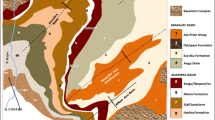Summary
The Whin Sill is a dolerite intrusion with extensive outcrops in North East England. Quarries in the sill, provide the bulk of the crushed rock aggregates in the region suitable for roadstone. The dolerite is generally of high strength and little affected by weathering and thus yields high quality aggregates. At some quarries, however, dolerite of poor quality, locally known as “Woodhead”, is found. The “Woodhead” material differs from the normal dolerite is having a distinctive colour, lower strength and higher porosity. It can be shown that the material is produced by hydrothermal alterations related to calcite veining. Inclusion of Woodhead material in aggregates from one quarry lead to their rejection by a Local Authority and, as it proved impossible to separate the poorer material, the quarry closed.
Quality variations have been determined by a range of standard tests. Test results can be related to petrographic indices determined by quantitative thin-section analyses.
Résumé
Le sill de Whin correspond à une intrusion doléritique, affleurant largement dans le Nord-Est de l'Angleterre. Les carrières dans ce sill fournissent la plupart des granulats pour les chaussées de la région. La dolérite, généralement peu altérée et de résistance élevée, donne des granulats de bonne qualité. Cependant, dans quelques carrières, une dolérite de mauvaise qualité est connue sous le nom local de “woodhead”; ce matériau diffère de la dolérite saine, par une couleur distincte, une plus faible résistance et une plus grande porosité. Il est montré que ce faciès est dû à une altération hydrothermale, en relation avec des filons de calcite. Une certaine proportion de “woodhead” dans les granulats a entraîné leur refus par les autorités locales et la fermeture de la carrière, car il était impossible de les séparer.
Les variations de qualité de ces matériaux ont été déterminées par des essais, dont les résultats sont corrélés avec des indices pétrographiques quantitatifs mesurés en lames minces.
Similar content being viewed by others
References
ASHURST J. and DIMES F.G. (1977): Stone in Building, The Architectural Press Ltd. London, pp. 105.
ASTM. (1980): Standard test method for soundness of aggregates by use of sodium sulphate or magnesium sulphate. Designation: ANSI/ASTM C88-76. Annual Book of ASTM Standards, Part 14, 48–53.
BRITISH STANDARD 812. (1975): Methods for sampling and testing of mineral aggregates, sands and fillers. Part 1–4. British Standards Institution. London.
BRITISH STANDARD 882 and 1201. (1973): Specification for aggregates from natural sources for concrete (including granolithic). British Standard Institution. London.
DUNHAM A.C. and STRASSER-KING V.E.G. (1981): Petrology of the Great Whin Sill in the Throckley Borehole, Northumberland.Rep. Inst. Geol. Sci. No. 81/4, pp. 32. London, H.M.S.O.
G.S.A. COLOR-CHART. (1970): Rock Color Chart. The Geological Society of America. Boulder, Calorado, U.S.A. pp. 16.
HAMROL A. (1961): A quantitative classification of the weathering and weatherability of rocks. Proc. 5th Int. Conf. Soil Mech. and Found. Engng, Paris, 2, 771–774.
HIGGINBOTOM I.E. (1976): Section 11.1. General requirements for rocks and aggregatesin Anon. 1976. Applied Geology for Engineers, H.M.S.O. pp. 378.
HOLMES A. and HARWOOD H.F. (1928): The age and composition of the Whin Sill and the related dykes of the north of England.Mineral. Mag. 21, 493–542.
HOSKING J.R. (1970): Road aggregates and their testing. One day Symposium on Quarrying, Bristol University.
HOSKING J.R. and TUBEY L.W. (1969): Research on low-grade and unsound aggregates. Road Research Laboratory Report LR 293, pp. 30.
IRFAN T.Y. and DEARMAN W.R. (1978): The engineering petrography of a weathered granite in Cornwall, England.Q. Jl. Engng Geol. 11, 233–244.
MENDES F.M., Aires-Barros L. and RODRIGUES F.P. (1966): The use of modal analysis in the mechanical characterization of rock. Proc. 1st Cong. Int. Soc. Rock Mech., Lisbon, 1, 217–223.
WEINERT H.H. (1964): Basic igneous rocks in road foundations. S. African Council Sci. Ind. Res., Res. Dept. 218.Natl. Inst. Road Res., Bull., 5, pp. 47.
Author information
Authors and Affiliations
Rights and permissions
About this article
Cite this article
Dearman, W.R., Irfan, Y., Money, M.S. et al. Quality variations in whin sill aggregates from Northumberland, England. Bulletin of the International Association of Engineering Geology 29, 355–359 (1984). https://doi.org/10.1007/BF02594435
Published:
Issue Date:
DOI: https://doi.org/10.1007/BF02594435




